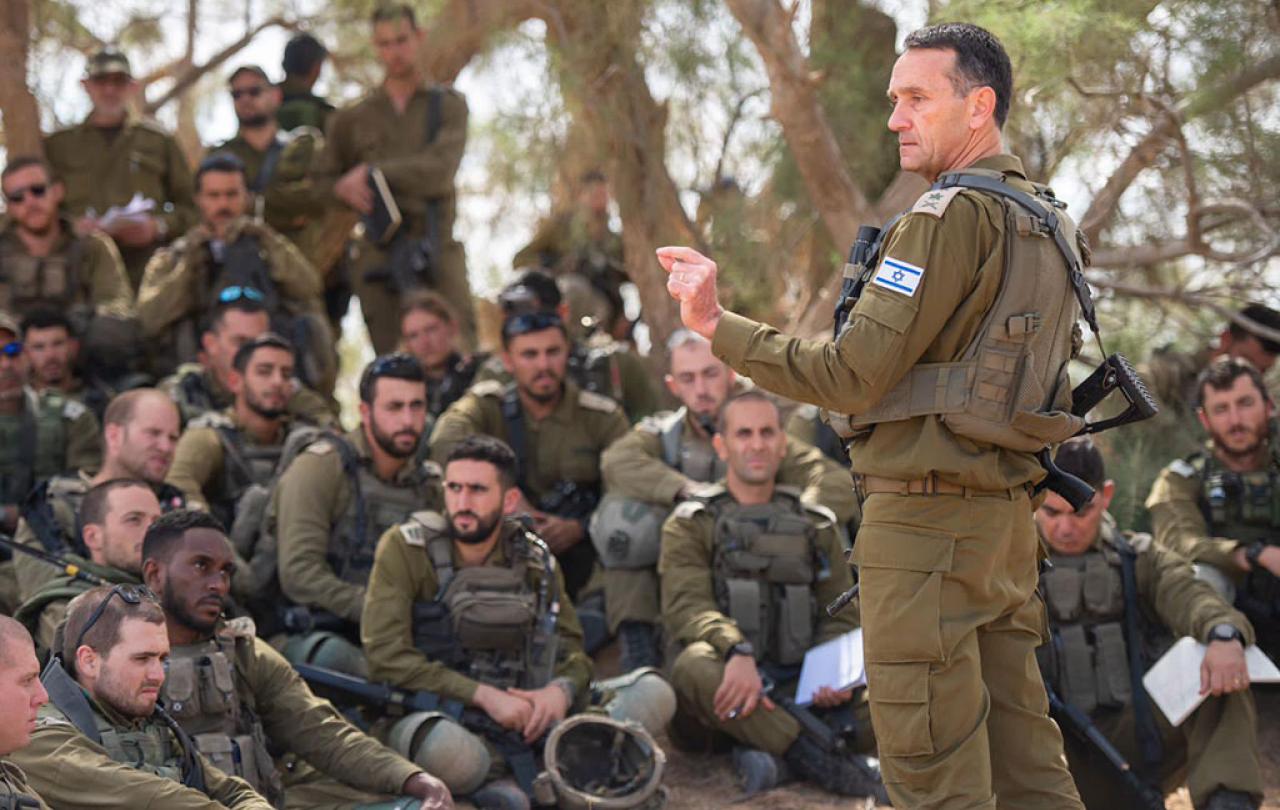
The horrific, indiscriminate attacks against Israel by Hamas terrorists have brought the larger Israel-Palestine conflict back to centre stage in international politics. The event has been called “Israel’s 9/11”, and senior Israeli political and military officials have vowed to “exact a price that will be remembered by [Hamas], and Israel’s other enemies, for decades to come.” , and to turn Gaza into a “city of tents”. Israel has begun bombarding thousands of Hamas targets and preparing for a ground invasion in Gaza.
The die thus seems to be cast for a long and costly war which may not ultimately be able to achieve its aims, and that will halt or reverse any progress towards a resolution of the Israel-Palestine conflict in at least two ways.
Much more important is that fair-minded Palestinians and their supporters in the wider Arab and western world are also able to understand Israel’s military actions as fitting and discriminate.
First, the trauma resulting from a large-scale Israeli air and ground campaign in Gaza will be enormous for Palestinians. This trauma will almost certainly be the seedbed of resentment which gives the next generation of Gazans sufficient reason to hate Israel and work for its demise. Indeed, if the tragedy of October 7 is Israel’s “9/11” then it is imperative that Israel not neglect the difficult lesson the US learned through its “war on terror”: when you punish terrorists in a manner that destabilizes and alienates the wider population of a region, you merely create more terrorists. This is not to say that responding to Hamas’ attacks with military force is unjust. Military action should form part of a just response to Hamas’ actions. But this military action needs to be conducted carefully. Any military judgement must be done in such a way that not only Israelis and sympathetic westerners see it as a rightful judgement on Hamas. Much more important is that fair-minded Palestinians and their supporters in the wider Arab and western world are also able to understand Israel’s military actions as fitting and discriminate. This would require Israel, at minimum, to go to extraordinary lengths to minimize civilian casualties, even to the point of significantly increasing risks to Israeli soldiers.
In the recent past, however, and perhaps also now, Israel’s military strategy, known as the ‘Dahiya Doctrine’ has geared in the opposite direction: it deliberately strikes back at enemy targets in a disproportional manner, in an effort to deter the enemy from further aggression. And when it faces a choice between increasing risks to Israeli soldiers or civilian populations, it often chooses the latter. If that strategy continues to play itself out in a drawn-out air and land campaign, any short-term military victory will only result in long-term creation of new and more determined enemies of Israel.
A long and costly ground war against Hamas will only make things worse for Israelis and Palestinians.
Second, Israel’s pursuit of a war against Hamas makes it all but impossible for the wider Arab world to pursue normalization of ties with Israel. Prior to Israel’s declaration of war, a fresh start was within reach. The 2020 Abraham Accords normalized ties between Israel and Bahrain, Morocco, and the United Arab Emirates, and this year an historic, US-brokered deal between Israel and Saudi-Arabia was well on its way to being agreed. Now, the Israel-Saudi deal is in tatters, and other Arab countries with diplomatic ties to Israel are feeling political pressure to show distance. This pressure is not arising because any of these Arab countries support Hamas. All are opposed to its Islamist ideology. It is because they are tied by bonds of affection and loyalty to the Palestinian people, and these bonds prevent Arab countries from negotiating in good faith with Israel when they have serious doubts that Israel’s military actions are making sufficient provision for the welfare of ordinary Palestinians.
A long and costly ground war against Hamas will only make things worse for Israelis and Palestinians. But what would make things better? Rather than a vengeful justice, Israel might consider pursuing what is called ‘redemptive justice’ in its war against Hamas.
This kind of justice is exactly the path Jesus urges his followers to follow in his Sermon on the Mount:
“You have heard that it was said, ‘Eye for eye, and tooth for tooth.’ But I tell you, do not resist by evil means. If anyone slaps you on the right cheek, turn to them the other cheek also.
The teaching here about retaliation has three parts.
First, Jesus presents a traditional teaching from the Mosaic law, sometimes called the lex talionis: ‘You have heard that it was said, “An eye for an eye and a tooth for a tooth.”’ In its Old Testament contexts, this principle was supposed to prevent violence from spiraling out of control. When someone wronged you, your injury didn’t give you unlimited right of revenge. Wrongdoing had to be addressed with strict retribution. No more.
Next, Jesus warns of a deeper dynamic which leads to problems: ‘But I say to you, do not resist by evil means’. Jesus’ warning is not opposed to the lex talionis. What Jesus is warning about, as New Testament commentator Peter Leithart argues, is not to apply this law in ways that perpetuate violence rather than limit it. The example Jesus gives next is illuminating: a slap on the right cheek is not a violent threat to life. To slap someone on the right cheek, you must use either your left hand, or the back of your right hand. Either of these would have been understood as acts of dishonour and shame to a first century Jew. They were not acts intended to harm grievously. And when someone is intent on publicly shaming or dishonouring you, responding with a counter-act of shame or dishonour only heightens the antagonism between you and encourages further retaliation. Strict retribution in these situations will not achieve the law’s aim of limiting violence.
This leads us to the third part of the teaching, where Jesus proposes a creative solution to the danger: rather than respond to dishonour with dishonour and risk creating a cycle of vendetta, take the penalty of the law on yourself he says – “accept the second slap rather than giving it” as Leithart puts it. This is what redemptive justice means. It cuts evil off at its root and restores a relationship of peace. After all, a person seeking to humiliate you runs out of ammunition very quickly when you show yourself willing to be humiliated.
Lex talionis is a principle which limits violence to strict retribution. Adopting this approach would require Israel’s leadership to renounce formally the “Dahiya Doctrine.”
How then might Israel’s political and military leadership enact redemptive righteousness in the situation it now faces in Gaza and in the areas under its effective control? First, let me say it again, Jesus’ commands do not abolish the lex talionis “an eye for an eye, a tooth for a tooth”. Judgement via military force against Hamas is thus not forbidden by the Sermon on the Mount. But as was noted earlier, the lex talionis is a principle which limits violence to strict retribution. Adopting this approach would require Israel’s leadership to renounce formally the “Dahiya Doctrine” and commit publicly to a more proportionate, discriminate form of retaliation to the Hamas attacks.
Second, we should note that the political situation which has been created by these attacks has deeper dynamics than merely trying to achieve justice for the victims of the attack. The situation also has important dynamics of shame and honour. Unable to prevent this horrific tragedy, the competency of Israeli political and military leaders has been called into question. They have been humiliated by these attacks, and the great temptation for them now is to ‘resist by evil means’, projecting strength by responding to dishonour with counter-dishonour, humiliation with counter-humiliation. This teaching warns Israel’s leadership to do otherwise: accept the second slap, rather than give it. Although it may sound counter-intuitive, allow yourself to be humiliated by Hamas rather than perpetuate further humiliation that will alienate the wider Palestinian population and potential Arab allies. Undercut the cycle of humiliation by going out of your way to honor ordinary Palestinians, protecting them from harm and blessing them even if it means incurring greater risks to your own soldiers or civilian population. This is the kind of bold, innovative leadership that Graham Tomlin has argued is needed in this most complex of global conflicts.
Would adopting such a self-sacrificial military strategy be ultimately self-defeating? Would it weaken Israel’s military advantage and prevent them from achieving victory over Hamas? The opposite is true. The Israeli military, with its superior military capability, is not at all in danger of ceding victory to Hamas by fighting a more self-sacrificial form of warfare. But if Israel fails to adopt a self-sacrificial strategy as it pursues military action, the sweetness of any initial victory will sour into a long-term defeat as the contagion of resentment is sown among a new generation of Palestinians and their supporters.
But surely this would be politically unfeasible for Israel’s leadership to implement? Any leader who enacted redemptive justice towards Hamas and the wider Palestinian population amidst the current national mood of mourning and outrage would face certain political demise. That may be so. Jesus warns those who follow him that they must be prepared to take up their cross. What would motivate that kind of decision, given the cost? The confidence to enact redemptive justice cannot ultimately be separated from confidence that death has been overcome through resurrection, bringing life to the whole world. The call to enact redemptive justice can only be sustained with a recognition of both the wisdom and the ultimate victory of the Jew from Nazareth.
Israel’s leadership is at a cross-roads. In response to the horrific attacks of Hamas, it has begun a severe bombing campaign in pursuit of a vengeful justice that will soon be followed by a ground invasion. If it wants long-term peace, it must consider changing course quickly and drastically. It must pursue the redemptive justice of the crucified Messiah that overcomes evil with good.





